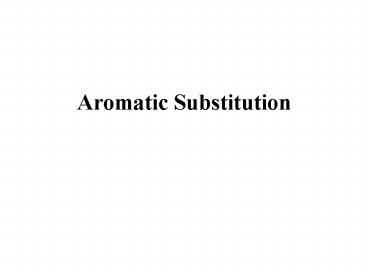Aromatic Substitution - PowerPoint PPT Presentation
1 / 23
Title:
Aromatic Substitution
Description:
1. The SEAr mechanism ... b. Chlorination (same mechanism as for bromination) Iodination does not occur this way. ... The Addition-elimination mechanism (ORA 622) ... – PowerPoint PPT presentation
Number of Views:37
Avg rating:3.0/5.0
Title: Aromatic Substitution
1
Aromatic Substitution
2
Outline 1. The SEAr mechanism 2. Electrophilic
substitution in substituted benzenes, polycyclic
and heterocyclic compounds 3. Electrophilic
halogenation 4. Electrophilic nitration 5.
Electrophilic sulfonation 6. Electrophilic
alkylation 7. Electrophilic acylation 8. Coupling
with diazonium compounds 9. Substitution of
groups other than hydrogen 10. Nucleophilic
aromatic substitution. The Addition-elimination
mechanism 11. Nucleophilic aromatic
substitution. The Elimination-addition mechanism
3
1. The SEAr mechanism
4
(No Transcript)
5
2. Electrophilic substitution in substituted
benzenes, polycyclic and heterocyclic compounds
Electronic effect of substituents at the benzene
ring
a. Inductive acceptor. The atom of the
substituent, connected to the benzene ring, has
higher electronegativity, than H. Examples
-OCH3, -NH2, -Cl, -NO2
b. Resonance acceptor. Conjugation between
p-orbitals is depicted by resonance structures
with the positive charge in the benzene ring.
Examples -COR, -NO2, -SO3H
c. Resonance donor. Conjugation between
p-orbitals is depicted by resonance structures
with the negative charge in the benzene ring.
Examples -OCH3, -NH2, -Cl, -phenyl
6
d. Hyperconjugative donor. Conjugation, involving
s-orbitals, is depicted by non-classical
resonance structures (allowing breaking s-bonds)
with the negative charge in the benzene ring.
Examples -CH3, -Alkyl
e. Hyperconjugative acceptor. Conjugation,
involving s-orbitals, is depicted by
non-classical resonance structures (allowing
breaking s-bonds) with the positive charge in
the benzene ring. Examples -CF3
7
Substituent effect on reactivity of substituted
benzenes
Electron donors increase reactivity in
SEAr Examples -CH3, -NR2, -OR, -CHCH2 Electron
acceptors decrease reactivity in SEAr Examples
-NO2, -NH3, -COR, -Cl
For substituents with opposite effects, the
resonance effect overrides all other
effects, except for chlorine and bromine, where
the inductive effect is the strongest.
Example of activation
8
Directing effect of substituents (already present
at the benzene ring before substitution) on
substitution
All electron donors direct the incoming
substituent to the ortho- and para-positions
(regardless of any accepting effects) Examples
-CH3, -NR2, -OR, -Cl, -Br, -CHCH2
9
Pure electron acceptors direct the incoming
substituent to the meta-position Examples -NO2,
-NH3, -COR, -CF3
10
Examples of orientation
Consistent orientation
Inconsistent orientation A
donor substituent overrides an acceptor
substituent. A resonance
donor overrides a hyperconjugative donor
11
(No Transcript)
12
The above considerations of the reaction
intermediate work better for less active
electrophilic agents and worse - for more active
electrophilic agents
13
3. Electrophilic halogenation (ORA 588)
a. Bromination
14
b. Chlorination (same mechanism as for
bromination) Iodination does not occur this
way. Fluorination proceeds through a different
mechanism.
4. Electrophilic nitration
15
5. Electrophilic sulfonation
SO3 can also be generated in situ by heating of
H2SO4. Sulfonation is reversible
16
6. Electrophilic alkylation
17
Alkylation, catalyzed by aluminium chloride, can
be complicated by carbocation rearrangements
18
7. Electrophilic acylation (ORA 593)
19
8. Coupling with diazonium compounds
Diazonium salts (generated by diazotization of
amines) react only with highly activated aromatic
compounds (amines, phenolates)
Sometimes the last step of deprotonation can be
rate-limiting
This reaction is an industrial way of production
of some dyes and acid-base indicators
20
9. Substitution of groups other than hydrogen
Besides of hydrogen, the following groups can
often be substituted -SO3H, -alkyl, -halogen
(X), -SiR3
Examples
21
10. Nucleophilic aromatic substitution. The
Addition-elimination mechanism (ORA 622)
Neither SN2 nor SN1 mechanisms are accessible for
aromatic nucleophilic substitution
The first, rate-limiting step does not involve
the leaving group. Reactivity of halides
FgtClgtBrgtI
22
Most common leaving groups Hal-, CH3O-, NO2-,
RSO2-, H-
The leaving group is highly activated by ortho-
and para-electron withdrawing substituents.
23
11. Nucleophilic aromatic substitution. The
Elimination-addition mechanism (ORA 625)
This mechanism takes place if there are no
electron-withdrawing substituents in the
molecule

